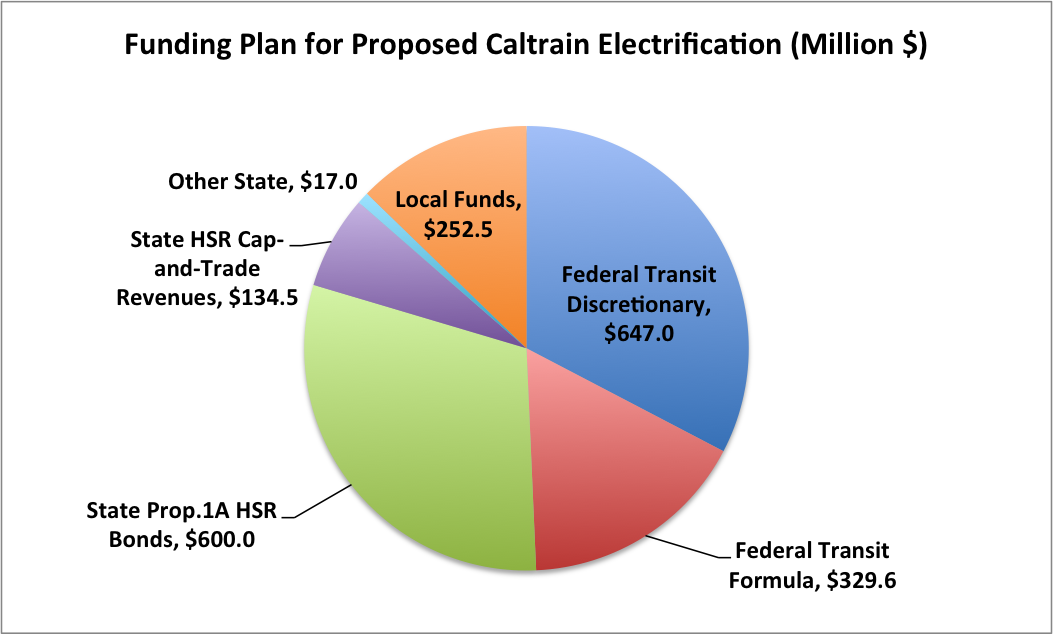February 23, 2017
The U.S. Department of Transportation last week put a three-month delay on the execution of a deal that would commit $647 million in future Federal Transit Administration (FTA) discretionary appropriations towards a $2 billion plan to electrify the Caltrain commuter railroad in the San Francisco Bay area.
FTA notified Caltrain that the execution of their project agreement would have to wait until FTA assembles its annual budget request for 2018, which is tentatively slated for mid-May.
The management of Caltrain immediately issued a statement saying that Caltrain has already awarded contracts and issued a Limited Notice to Proceed that allowed preliminary work to begin, adding “A Full Notice to Proceed (NTP) must be issued by March 1, 2017, in order to maintain the terms of the contracts and avoid costly penalties and project delays. Before an NTP can be issued, [Caltrain’s governing body] must receive the $647 million Full Funding Grant Agreement (FFGA) from the Federal Transit Administration’s (FTA) Core Capacity grant program.”
But it is routine for a new Administration to delay the execution of new FFGAs (which are like contracts, but are not exactly legally binding on the federal government) until the new Administration can finalize its overall plan for the Capital Investment Grant program for new fixed guideway systems. This annual plan, called the New Starts Annual Report, is always submitted along with the President’s annual budget.
And a new President’s first budget is always very late (it now looks like the Trump budget and New Starts report will be mid-May), which is why outgoing Administrations try to execute as many pending FFGAs as possible before January 20.
Here is what the George W. Bush Administration did on the way out the door in January 2009:
- January 9, 2009 – signed a FFGA promising $428 million for a light rail extension in Utah.
- January 15, 2009 – signed a FFGA promising $813 million for a project in Seattle.
- January 16, 2009 – signed a FFGA promising $309 million for a project in Denver.
Not to be outdone, the Obama Administration also tried its best to clear the slate prior to January 20, 2017:
- December 15, 2016 – signed a FFGA promising $499 million to build a commuter rail system in Fort Worth.
- January 4, 2017 – signed a FFGA promising $1.187 billion (plus a $307 million federal loan) for the Los Angeles Westside subway extension.
- January 9, 2017 – signed a FFGA promising $1.07 billion to upgrade the Red and Purple lines in Chicago.
So the real question is: why didn’t the Caltrain agreement get executed under the Obama Administration?
The answer appears to be delays among the local governments in the Bay Area in formally approving their revised share of the funding. Last May, the local governments that collectively run Caltrain reached a memorandum of understanding (MOU) amongst themselves and the California High Speed Rail Authority (CHSRA), which is funding a huge share of the project, on final funding levels. On the strength of that MOU, the Federal Transit Administration revised its funding rating of the project in August 2016 to Medium-High.
However, the meeting agenda for the San Francisco County Transportation Authority on January 5, 2017 indicates that sometime last fall (a bit before the elections), FTA demanded that the various Caltrain funding agencies demonstrate that they have the capacity to absorb cost overruns up to $200 million, if the existing $316 million overrun contingency is exceeded. The local governments then sent letters to FTA in mid-November assuring them that they had the capacity, and then in mid-December, FTA demanded that the local governments pass formal resolutions on the subject, and this took until early January.
Acting FTA Administrator Carolyn Flowers recommended approval for the FFGA on January 18, 2017 – but under 49 U.S.C. §5309(k)(5), FTA then had to submit the proposed FFGA to Congress for a 30-day waiting period before execution, which pushed the issue past January 20 and into the Trump Administration’s lap.
Unlike other mass transit projects, the Caltrain electrification project is inextricably bound up with the struggling California high-speed rail project. Although Caltrain electrification has it own merits, 30 percent of the Caltrain money ($600 million) is to be paid out of the $9.9 billion in high-speed rail bonds approved by Golden State voters in November 2008, and another $134.5 million is to be paid out of the cap-and-trade allowance auction proceeds that have been dedicated to the high-speed rail project.
The electrification of the Caltrain track will be to high-speed rail standards and will allow the high-speed rail trains to slow down and share track with lower-speed Caltrain. (This was the slower, but much cheaper, alternative to condemning and bulldozing a bunch of really expensive Bay Area real estate in order to build dedicated high-speed rail right-of-way.)

Opponents of the California HSR project, led by House Railroads Subcommittee chairman Jeff Denham (R-CA) and House Majority Leader Kevin McCarthy (R-CA), regularly seize on each new bit of bad news about the project as an excuse to call for a halt to the whole thing.
In this case, the Los Angeles Times on January 13 ran an article quoting from what it said was a “confidential Federal Railroad Administration risk analysis” that indicated that the initial construction segment of the HSR project might run as much as $3 to $3.5 billion over the original budget of $6.4 billion.
This prompted Denham to get all of his California Republican colleagues to co-sign a January 24 letter to incoming Transportation Secretary Elaine Chao urging that “no further monies be granted to the [California High Speed Rail] Authority or the State of California for High Speed Rail until a full and complete audit of the project and its finances can be conducted, and those findings presented to the public.” The letter listed the “additional $650 million in grants from the federal government to electrify its line from San Jose to San Francisco for use by both transit and high-speed rail service” as part of the high-speed rail money that should be suspended.
(Ed. Note: Part of the confusion comes from the fact that this project crosses stovepipes – the Caltrain electrification grant is funded and overseen by FTA while the California HSR project is funded and overseen by the Federal Railroad Administration. In order to receive a construction grant from the FTA Capital Investment Grant program, a project must have all its planning and environmental paperwork complete, must have all of its non-federal funding completely nailed down, and (in the case of new construction) must construct an entire usable segment. FRA, on the other hand, did not insist on any of those requirements before giving the California HSR project billions of dollars towards construction, which is a major part of the problem.)
But as problematic as the California high-speed rail project is, the Caltrain grant probably would have been delayed even if it was completely unrelated to the HSR project. Not only do new Presidents always take time to regroup before signing multi-year budgetary commitments negotiated by the prior Administration, but the Trump Administration may be about to propose significant cuts to the Capital Investment Grant program.
The 2016 Republican Party platform promised to “phase out the federal transit program” because, it says, transit is “an inherently local affair that serves only a small portion of the population, concentrated in six big cities.” And, as ETW wrote earlier this month, the new White House budget director, Mick Mulvaney, is working closely with alumni of the conservative Heritage Foundation, which produced an alternative budget that calls for the Capital Investment Grants program to be zeroed out immediately.
As we wrote, zeroing out the CIG account is clearly impossible – the sum total of the FFGAs that have already been signed include $1.6 billion in total appropriations in the still-unfinished 2017 budget cycle and almost $5 billion in appropriations in future years. “While these FFGAs all contain language ensuring that they are not a legal obligation on behalf of the federal government (else the federal appropriations would be part of the mandatory budget, not the discretionary budget), they do carry a lot of moral weight, and local governments are in the process of spending a lot of their own money based on the promises of future federal aid on the schedule written into the FFGAs.”
In the still-unfinished 2017 budget process, the House Appropriations Committee provided $2.5 billion for the CIG account and the Senate panel provided $2.3 billion. Both bills provided the full $1.2 billion for installment payments of FFGAs that were signed at the time of the budget submission, and both provided funding for proposed new starts as well.
(Both bills provided the requested $100 million for the 2017 installment of the Caltrain project, if the agreement were to be executed. And it is worth noting that of the $647 million federal CIG total appropriations request for the Caltrain project, $73 million has already been appropriated for pre-construction work and will be lost if the project is canceled.)
As the Trump Administration plans the FY 2018 budget request, the installment payments due on already-signed FFGAs will be about $1.1 billion, and if the Caltrain agreement gets signed, that will add another $100 million to the total.
The next FFGA on the horizon is the Minneapolis Southwest light rail project, and the Maryland Purple Line project was ready to have its FFGA executed before a last-minute court ruling put the project on hold.






